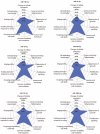HypoxaMIRs: Key Regulators of Hallmarks of Colorectal Cancer
- PMID: 35741024
- PMCID: PMC9221210
- DOI: 10.3390/cells11121895
HypoxaMIRs: Key Regulators of Hallmarks of Colorectal Cancer
Abstract
Hypoxia in cancer is a thoroughly studied phenomenon, and the logical cause of the reduction in oxygen tension is tumor growth itself. While sustained hypoxia leads to death by necrosis in cells, there is an exquisitely regulated mechanism that rescues hypoxic cells from their fatal fate. The accumulation in the cytoplasm of the transcription factor HIF-1α, which, under normoxic conditions, is marked for degradation by a group of oxygen-sensing proteins known as prolyl hydroxylases (PHDs) in association with the von Hippel-Lindau anti-oncogene (VHL) is critical for the cell, as it regulates different mechanisms through the genes it induces. A group of microRNAs whose expression is regulated by HIF, collectively called hypoxaMIRs, have been recognized. In this review, we deal with the hypoxaMIRs that have been shown to be expressed in colorectal cancer. Subsequently, using data mining, we analyze a panel of hypoxaMIRs expressed in both normal and tumor tissues obtained from TCGA. Finally, we assess the impact of these hypoxaMIRs on cancer hallmarks through their target genes.
Keywords: HIF-1α; angiogenesis; hypoxaMIR; metastasis; miRNA network; miRNA regulation; microRNAs; transcription factor.
Conflict of interest statement
The authors declare no conflict of interest.
Figures






Similar articles
-
Hypoxia: a master regulator of microRNA biogenesis and activity.Free Radic Biol Med. 2013 Sep;64:20-30. doi: 10.1016/j.freeradbiomed.2013.05.022. Epub 2013 May 24. Free Radic Biol Med. 2013. PMID: 23712003 Free PMC article. Review.
-
Up-regulation of hypoxia-inducible factors HIF-1alpha and HIF-2alpha under normoxic conditions in renal carcinoma cells by von Hippel-Lindau tumor suppressor gene loss of function.Oncogene. 2000 Nov 16;19(48):5435-43. doi: 10.1038/sj.onc.1203938. Oncogene. 2000. PMID: 11114720
-
Oxygen-dependent ubiquitination and degradation of hypoxia-inducible factor requires nuclear-cytoplasmic trafficking of the von Hippel-Lindau tumor suppressor protein.Mol Cell Biol. 2002 Aug;22(15):5319-36. doi: 10.1128/MCB.22.15.5319-5336.2002. Mol Cell Biol. 2002. PMID: 12101228 Free PMC article.
-
Role of hypoxia-inducible factor (HIF)-1alpha versus HIF-2alpha in the regulation of HIF target genes in response to hypoxia, insulin-like growth factor-I, or loss of von Hippel-Lindau function: implications for targeting the HIF pathway.Cancer Res. 2006 Jun 15;66(12):6264-70. doi: 10.1158/0008-5472.CAN-05-2519. Cancer Res. 2006. PMID: 16778202
-
Melatonin and the von Hippel-Lindau/HIF-1 oxygen sensing mechanism: A review.Biochim Biophys Acta. 2016 Apr;1865(2):176-83. doi: 10.1016/j.bbcan.2016.02.004. Epub 2016 Feb 17. Biochim Biophys Acta. 2016. PMID: 26899267 Review.
Cited by
-
Persistent and novel changes in plasma microRNA profiles in patients with non-small cell lung cancer following tumour resection.Transl Lung Cancer Res. 2025 Mar 31;14(3):677-706. doi: 10.21037/tlcr-24-626. Epub 2025 Mar 27. Transl Lung Cancer Res. 2025. PMID: 40248723 Free PMC article.
-
Anti-angiogenesis in colorectal cancer therapy.Cancer Sci. 2024 Mar;115(3):734-751. doi: 10.1111/cas.16063. Epub 2024 Jan 17. Cancer Sci. 2024. PMID: 38233340 Free PMC article. Review.
-
STELLAR-303: randomized phase III study of zanzalintinib + atezolizumab in previously treated metastatic colorectal cancer.Future Oncol. 2024;20(24):1733-1743. doi: 10.1080/14796694.2024.2352276. Epub 2024 Jul 23. Future Oncol. 2024. PMID: 39041200 Free PMC article.
-
Ochratoxin A induces endoplasmic reticulum stress and fibrosis in the kidney via the HIF-1α/miR-155-5p link.Toxicol Rep. 2023 Jan 18;10:133-145. doi: 10.1016/j.toxrep.2023.01.006. eCollection 2023. Toxicol Rep. 2023. PMID: 36714464 Free PMC article.
-
Cigarette smoke-induced exosomal miR-221-3p facilitates M1 macrophage polarization via the STAT3 pathway in chronic obstructive pulmonary disease.Aging (Albany NY). 2024 Aug 29;16(17):12379-12391. doi: 10.18632/aging.206095. Epub 2024 Aug 29. Aging (Albany NY). 2024. PMID: 39213192 Free PMC article.
References
Publication types
MeSH terms
Substances
LinkOut - more resources
Full Text Sources
Medical

